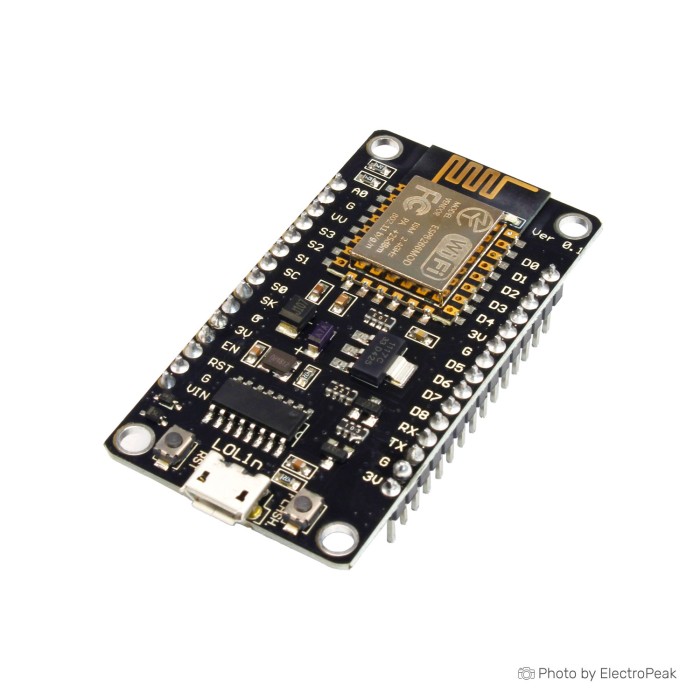NodeMCU is a development board that utilizes the ESP8266 or ESP32 modules. It simplifies the development process by providing a ready-to-use platform with built-in USB-to-serial programming and voltage regulation.
NodeMCU ESP8266 V3 Lua CH340G Wi-Fi Development Board
 ESP-201 ESP8266 WiFi Module
Previous
ESP-201 ESP8266 WiFi Module
Previous

The NodeMCU ESP8266 CH340G is a powerful and widely-used development board that combines the ESP8266 microcontroller with integrated Wi-Fi capabilities. This board offers a user-friendly platform for creating Internet of Things (IoT) projects, web-based applications, and data streaming. The inclusion of the CH340G USB-to-serial converter simplifies programming and communication, making it accessible to both beginners and experienced developers. With its ample GPIO pins, the NodeMCU ESP8266 CH340G provides flexibility for connecting sensors, actuators, and other components, allowing you to realize a diverse range of projects.
Specificatoins of NodeMCU ESP8266 CH340G Wi-Fi Development Board:
- Microcontroller: ESP8266 -12E (Tensilica Xtensa LX106)
- Operating Voltage: 3.3V (Note: The GPIO pins are not 5V tolerant, so be cautious when interfacing with 5V components.)
- Clock Speed: Typically operates at 80 MHz, but can be configured at different speeds.
- Flash Memory: 4MB (32Mbit) Flash memory for program storage.
- Wi-Fi: Integrated 802.11 b/g/n
- GPIO Pins: 17 GPIO pins (D0 to D8, RX/TX, A0, SDA, and SCL).
- Analog Input: A0 pin for analog input (10-bit resolution).
- Communication Interfaces: Serial communication (TX/RX). I2C (A4/SDA, A5/SCL). SPI.
- USB-to-Serial Converter: CH340G (commonly used on many NodeMCU boards)
Key features of the NodeMCU ESP8266 CH340G Dev. Board
The NodeMCU ESP8266 CH340G has several key features that make it a popular choice for IoT projects and prototyping.
- ESP8266 Microcontroller: System-on-a-chip (SoC) that integrates a low-power 32-bit microcontroller with built-in Wi-Fi connectivity.
- USB-to-Serial Converter (CH340G): Features the CH340G USB-to-serial converter chip.
- Programming: The ESP8266 can be programmed using the Arduino IDE, MicroPython, Lua, and other programming environments.
- GPIO Pins: Provides a set of General Purpose Input/Output (GPIO) pins that can be conneted to external devices such as sensors, LEDs, and other components.
- Analog Pins: Read analog voltages from 0 to 3.3v using ADC on ESP8266 SOC.
- Open-Source Community Support: Benefits from a vibrant and active open-source community that provides support, documentation, and a variety of libraries to facilitate development.
- Compact Form Factor: The NodeMCU ESP8266 CH340G has a compact and convenient form factor, making it suitable for small-scale projects and prototyping.
- Low Cost: One of the key attractions is its low cost, making it an affordable option for hobbyists, students, and developers looking to experiment with IoT and wireless communication.
Who is recommended to buy NodeMCU ESP8266 CH340G Dev. Board?
The ESP8266 has found widespread adoption in a variety of IoT (Internet of Things) and embedded applications due to its affordable price, built-in Wi-Fi capabilities, and ease of use. Some of the most popular use cases for the ESP8266 include: home automation projects, making IoT devices,s agriculture system, DIY smart gadgets, build weather stations.
The versatility and affordability of the ESP8266 make it a popular choice for hobbyists, students, and professionals looking to prototype and deploy IoT solutions in a wide range of applications.
NodeMCU ESP8266 Dev. Board Pinout
Below, you can see the pinout of NodeMCU ESP8266 Dev. Board. Each of the pins has a special function. For more details about the pinout of this module and other ESP8266 based modules, you can read this page.
Power and Reset:
- 5V: External 5V power supply.
- GND: Ground.
- VIN: 5V or higher power supply
- RST: Reset program running now
GPIO Pins:
- 17 multipurpose GPIO pins
Peripheral ports :
- I2C, UART, SPI(HSPI & SSPI)
What you need to get started with NodeMCU ESP8266 CH340G Dev. Board?
To get started with the NodeMCU ESP8266 CH340G Development Board, you'll need the following:
- USB Cable (Micro USB): A micro USB cable is required to connect the NodeMCU board to your computer. This cable serves both as a power source and a means for programming the board.
- Computer: You'll need a computer to write, compile, and upload code to the NodeMCU board. The development environment can be the Arduino IDE, PlatformIO, or any other compatible IDE.
- USB-to-Serial Driver (CH340G Driver): The NodeMCU CH340G board uses the CH340G USB-to-serial converter. Install the CH340G driver appropriate for your operating system. You can read this article to know how to do it.
- Optional: Breadboard and Jumper Wires: If you're working with external components or sensors, having a breadboard and jumper wires will help you create circuits on a temporary basis.
- Power Source: The NodeMCU board can be powered via the USB connection, but if you want to deploy it in a standalone application, you'll need a suitable power source. This could be a USB power adapter, a portable power bank, or a dedicated power supply.
FAQs
What is NodeMCU?
What is the ESP8266?
The ESP8266 is a low-cost Wi-Fi module with a built-in microcontroller (Tensilica Xtensa) designed for IoT applications. It gained popularity for its affordability, small size, and ease of use.
What is the difference between ESP8266 and ESP32?
The ESP32 is an upgraded version of the ESP8266, featuring dual-core processors, more GPIO pins, Bluetooth support, and additional features. ESP8266 is simpler and more cost-effective, while ESP32 offers more capabilities.
How can I program the ESP8266?
The ESP8266 can be programmed using various development environments, with the Arduino IDE being one of the most popular. Additionally, platforms like PlatformIO and Lua are also used for programming ESP8266. If you are using Arduino IDE, you can gain more information by reading Beginner's Guide to Get Started w/ ESP8266 on Arduino IDE. Also if you are interested in Python language, you can read €œHow to Program MicroPython on ESP8266
Who is not recommended to buy NodeMCU ESP8266 dev board?
While the NodeMCU ESP8266 development board is versatile and suitable for a broad range of users, there are certain scenarios where it might not be the best choice. Here are situations where the NodeMCU ESP8266 dev board might not be recommended:
If your project demands high processing power or requires advanced features not provided by the ESP8266 (such as high precision ADC or wide range of interface pins) , you might want to consider more powerful platforms such as the ESP32 or other microcontroller/microprocessor options. Also, if your project involves storing a substantial amount of data or requires extensive use of flash memory, you may have better choice than ESP8266.
Is ESP8266 faster than Arduino?
Comparing the speed of the ESP8266 and Arduino microcontrollers directly depends on the specific models being considered. In terms of clock speed alone, the ESP8266 generally operates at higher frequencies than some of the standard Arduino microcontrollers.
Can the ESP8266 be powered with 5V?
While the ESP8266 operates at 3.3V, it often has a voltage regulator that allows it to be powered by a 5V source through the Vin pin. However, GPIO pins are not 5V tolerant, so external components should operate at 3.3V.
Can the ESP8266 connect to the internet?
Yes, the ESP8266 has built-in Wi-Fi capabilities, allowing it to connect to wireless networks and access the internet. This feature is commonly used in IoT projects for data transmission and remote control.
What is the maximum range of Wi-Fi communication on the ESP8266?
The Wi-Fi range depends on various factors, including the environment and obstacles. In the basic model of this model, you can experience conditions similar to an old Android phone. In optimal conditions, the ESP8266 can typically achieve a range of around 100 meters.
How can I update the firmware on the ESP8266?
Firmware updates for the ESP8266 can be done using various methods, including over-the-air (OTA) updates, flashing via USB using tools like esptool, or using programming adapters.
Is the ESP8266 open source?
Yes, the ESP8266 module and its development tools are based on an open-source platform. Espressif, the company behind the ESP8266, provides the necessary software development kits (SDKs) and documentation for developers to work with the module.
If you're looking for alternative microcontroller boards with capabilities similar to the ESP8266 (NodeMCU), especially in terms of built-in Wi-Fi and ease of use, here are some alternatives:
Is there any alternative similar microcontroller boards to use instead of NodeMCU ESP8255 Dev Board?
- ESP8266 & ESP32 Dev Boards: ESP8266 and ESP32 Dev Boards are development boards based on the ESP32 microcontroller. It offers dual-core processing, Bluetooth, and other enhancements while maintaining compatibility with the Arduino IDE.
- Wemos D1 Mini (ESP8266 or ESP32): The Wemos D1 Mini series offers compact and feature-rich boards based on both ESP8266 and ESP32. They are compatible with the Arduino.
- SparkFun ESP8266 Thing: The SparkFun ESP8266 Thing is another alternative for ESP8266 development. It's compact and features an onboard USB-to-serial converter.
- Heltec ESP32 Dev-Boards: Heltec produces ESP32-based development boards with built-in OLED displays. These boards are suitable for projects that require display capabilities along with Wi-Fi.
- Wemos ESP8266 and ESP32 Boards: Wemos offers a variety of ESP8266 and ESP32 development boards with different form factors and features, including OLED displays and relay shields.
- NodeMCU ESP32: NodeMCU is also available with the ESP32 microcontroller, providing a similar development experience but with the added features of the ESP32. You can see it here.
- Arduino Nano ESP32: Arduino Nano ESP32 is based on the efficient and well-known ESP32-S3 chip, combining the support of the Arduino ecosystem with the capabilities of ESP and support for both Arduino and MicroPython.
Remember to consider factors such as GPIO pin count, form factor, and additional features when choosing a board. Most of these alternatives can be programmed using the Arduino IDE or other popular development environments, providing a similar programming experience to the NodeMCU ESP8266.






Please complete your information below to login.
Sign In
Create New Account